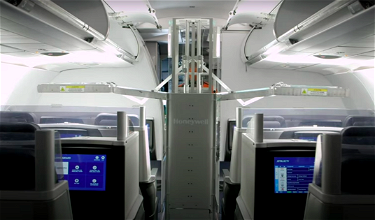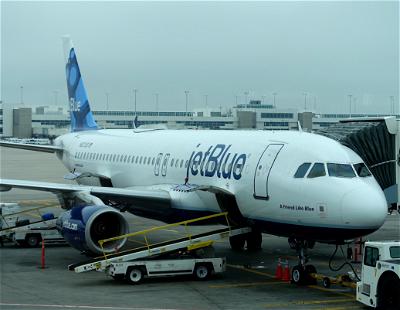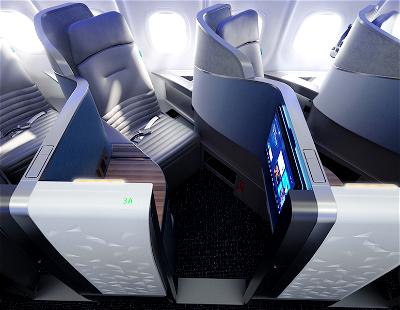We’ve seen virtually all airlines up their cleaning protocols, though JetBlue is piloting some really cool-looking technology.
JetBlue has become the first US airline to start using the Honeywell UV Cabin System, which can traverse an aircraft in less than 10 minute. In studies, ultraviolet light has been found to be capable of significantly reducing certain viruses and bacteria when properly applied at prescribed levels.
JetBlue so far has eight of these devices, and they’re being put to work at both New York JFK International Airport and Fort Lauderdale-Hollywood International Airport. JetBlue will be using these devices for a 90-day trial period, to evaluate the impact. This will of course be in addition to JetBlue using its current increased cleaning procedures.
The Honeywell UV Cabin System is about the size of a beverage cart, and has UV-C light arms that extend over the top of seats and sweep the cabin to treat aircraft surfaces. Properly applied, UV-C lights can deliver doses that clinical studies have found to be capable of reducing various viruses and bacteria, including SARS-CoV and MERS-CoV.
As JetBlue’s President and COO, Joanna Geraghty, describes this move:
“With the safety of our crew members and customers our first priority, JetBlue’s Safety from the Ground Up initiative is maintaining a layered approach to safety by ensuring healthy crew members, providing flexibility, adding space, reducing touchpoints, and keeping surfaces clean and sanitized. As we look to add additional layers of protection by utilizing cutting-edge technology, we have identified the Honeywell UV Cabin System as a potential game changer when it comes to efficiently assisting in our efforts to sanitize surfaces onboard.”
Here’s how Honeywell Aerospace’s President and CEO, Mike Madsen, describes this development:
“JetBlue took an immediate interest in this new product when we demonstrated it for them just a few weeks ago, and now JetBlue is receiving our first systems. We’ve ramped up production quickly on the UV Cabin System, and our company is working on a range of solutions to help make passengers more comfortable about flying.”
Here’s a video of this new Honeywell technology at work on a JetBlue plane:
Bottom line
JetBlue is the first US airline to trial the Honeywell UV Cabin System, which is intended to reduce viruses and bacteria on surfaces. This is being done in addition to all of JetBlue’s other current enhanced cleaning protocols.
Of course this sounds great in theory, but I’m curious to see how this will be used in practice. 10 minutes isn’t an insignificant amount of time when a plane is being turned, especially if this is to be done in conjunction with other cleaning procedures.
Furthermore, I realize I’m exceptionally clumsy, but am I the only one who wonders if this will operate as smoothly as the video suggests? This device is operating in tight spaces, and almost looks kind of fragile.
What do you make of this technology?





Tray tables are not even lowered. Also, that means they will need a second pass to disinfect the seats once the tables are put away.
Another reason why JetBlue is industry leading and the best. Mint, now this. Bravo!
A similar system is installed at my apartment complex to clean the common areas. Furthermore, we also have a UV tunnel to sanitise luggage and accessories.
All the companies should start considering the nano technology of the photocatalysis to sanitize.
It is an innovative solution based on the photocatalytic process, with no chemicals inside, it is not harmful for humans and animals, durable and sustainable. It will keep the surfaces treated sanitized for months because the oxidative process reactivate itself every time that it is in contact with the light (natural or artificial) and the humidity of the air. It...
All the companies should start considering the nano technology of the photocatalysis to sanitize.
It is an innovative solution based on the photocatalytic process, with no chemicals inside, it is not harmful for humans and animals, durable and sustainable. It will keep the surfaces treated sanitized for months because the oxidative process reactivate itself every time that it is in contact with the light (natural or artificial) and the humidity of the air. It is scientifically proven that is able to deactivate and dissolve bacteria and viruses (COVID-19 included) turning them into harmful molecules of air and mineral salts).
An efficient and healthy solution for a constant sanitation of every environment.
It’s about time! My doggie daycare has an ultraviolet light system, one of several strategies they have implemented to take care of their doggie clients. Human travellers deserved better precautions pre pandemic, and now increased cleaning and prevention procedures are critical. I hope more airlines adopt this new tool. And how about medical grade HVAC systems too!
10 minutes is the joke here. There is no way the UV is doing anything beyond maybe 6 inches at the speed needed to clean any plane in 10 minutes. This is just marketing. JetBlue gets this announcement then when the test is over Honeywell gets their marketing carts back.
For future aircraft designs, they could build UV lights into every bin, lavatory, closet, cargo bays, cockpit, and all through the cabins from multiple angles, all connected on a dedicated circuit and make sure nobody is on board or in the cargo bays, then activate for 10 minutes. No maneuvering the unit, no human exposure. If any lamp is out, the system could detect it so it can be remedied. This could be factory built-in...
For future aircraft designs, they could build UV lights into every bin, lavatory, closet, cargo bays, cockpit, and all through the cabins from multiple angles, all connected on a dedicated circuit and make sure nobody is on board or in the cargo bays, then activate for 10 minutes. No maneuvering the unit, no human exposure. If any lamp is out, the system could detect it so it can be remedied. This could be factory built-in useful standard content on new planes; retrofit of existing planes would be tough and expensive. Just an idea.
Now people will prefer the middle seats, looking at the video!
Now JetBlue should add UV Light treatment to the inlets and outlets of the plane's AC system. This will kill airborne viruses.
Line of sight
10 seconds to kill but that is from 6" away. I don't see this thing getting close to within 6" of most surfaces so that will require longer time.
JetBlue's not the first –– Alaska's been testing this system for at least the past month, although they haven't made any sort of formal announcement.
This system will certainly not reach the bathrooms, overhead bins and the cockpit.
From the way I see the arms extend I may not want that window seat any more
Just sayin.....
I actually got something similar for my house to sanitize my phone, it was a UV Phone sanitizer bag. Company was called
shophomewarrior.com
Why do people keep saying: "x isn't perfect, therefore there's no point"?
Sounds completely idiotic. Nothing is perfect, from seatbelts to vaccines to preventative health care. Doesn't mean you don't do it. It's cost vs. benefits, and if you don't have the data to show it's not worth it, then maybe let the experts determine it?
@Eugene: Not really, you use UV-C radiation, 254 nm wavelength that kills any germs (including virus) for few seconds. It's prettu common practice for germicidal research and virology.
Don't confuse this with our visible light. This radiation is monochromatic, and will reach in crevices if you just shove over the exposed surfaces and the penetration depth is quite strong. I am sure the crew also cleans with disinfectants.
But one has to make...
@Eugene: Not really, you use UV-C radiation, 254 nm wavelength that kills any germs (including virus) for few seconds. It's prettu common practice for germicidal research and virology.
Don't confuse this with our visible light. This radiation is monochromatic, and will reach in crevices if you just shove over the exposed surfaces and the penetration depth is quite strong. I am sure the crew also cleans with disinfectants.
But one has to make sure the whole body is protected from the UV-C radiation, otherwise, it will burn your skins and can cause skin cancer.
The 10 minutes is an additional 10 minutes as “mid range” 254nm will blind you and give you a sunburn without the ivy blocking protective plastic shield the machine used. Short wave 144 nm will blind you quicker. The article talks about the 100-280 mnl range. In transilluminates researchers use both nm wave lengths. Either range of UV will kill viruses and bacteria line of sight but the cabin must be completely cleared and double...
The 10 minutes is an additional 10 minutes as “mid range” 254nm will blind you and give you a sunburn without the ivy blocking protective plastic shield the machine used. Short wave 144 nm will blind you quicker. The article talks about the 100-280 mnl range. In transilluminates researchers use both nm wave lengths. Either range of UV will kill viruses and bacteria line of sight but the cabin must be completely cleared and double checked. So automatic self driving machines could be a health hazard and legal liability
I am not worried about the plane, but the people on it....
I’m much more concerned about airborne/person-to-person transition in confined spaces. Could I get Some sort of hat or suits that blasts that light 360°from me?
I don't understand some of the responses here. For example many hospitals will clean a CT scan room and then use UV light to help sanitize. B6 isn't the first ever to do this. There are multiple studies on UV light and viruses including recent DARPA work specifically on covid-19. Yes there is an issue of getting light into every crevice, but I don't think this is meant to be the only sanitizing solution here.
In my experience - human cleaners on airplanes only clean "line of sight" also (and some do not even do that much)
If it works even somewhat, its a great PR tool for B6
There's two issues with this solution: 1) as others have said, it's line of sight or wherever the UV can reach surfaces and 2) the power output of the UV lamps would need to be really high to kill COVID-19 for the length of time a surface is exposed when dragging the cart through the aircraft.
I'm siding with marketing buzz. They likely won't follow the directions properly and the setup doesn't meet requirements of what studies have shown.
It is an interesting idea that needs to be fleshed out a bit more to be practical. This could be an automated drone on an aircraft that runs after deplaning, potentially one of these per cabin, depending on weight. A comment above is correct, it is only effective against surfaces that it can get to, so pocket contents, under seats, etc are still a problem but this is still a good idea.
Magic Beans.
I hear that drinking Lysol works, too.
I assume this only reaches surfaces that have a line of sight. If you open the magazine or stick a tissue in that compartment you are back to covid concerns.
UV light kills bacteria and viruses, that's been proven. This is a very innovative solution, and I, for one, applaud JetBlue for implementing it!
Wow, I would've thought in today's world of self driving cars and automation, the robot would self drive down the aisle and just shine the light. Based on the video, it looks like someone has to push this thing. Now all I am waiting for is the lawsuits that the UV causes this and that on the person operating this machine.
“cool looking” is the operative phrase.
Jet Blue’s only experiment is to see if this convinces more people to fly with them.